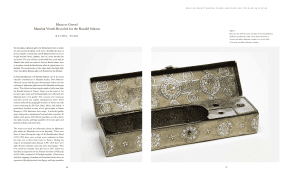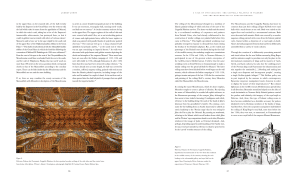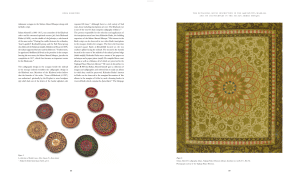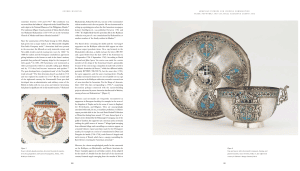Working to improve mutual understanding between the Middle East and the West
Working to improve mutual understanding between the Middle East and the West
No products in the basket.
£60.00
The essays in this volume bring to light artistic exchanges that occurred between successive Islamic dynasties in the central regions of the Middle East and further afield in China, India and Europe from the twelfth to the nineteenth century. All the articles present original research, many of them taking advantage of innovative scientific means to show familiar objects in a new light.
Subjects from the Mamluk period include tile production during the reign of Qaytbay, book bindings associated with Qansuh al-Ghawri, depictions of fish on Mamluk textiles, the relationship between Mamluk metalwork and Rasulid Yemen. A number of the articles are concerned with epigraphic inscriptions found on the buildings of the Fatimid, Mamluk and Ottoman periods, examining the inscriptions on the Mausoleum of Yahya al-Shabih in Cairo, and how a Mamluk inscription from the Madrasa Qartawiya in Tripoli is replicated in Istanbul during the Ottoman period. The relationship between ceilings of the Cappella Palatina in Palermo and the Mouchroutas Palace in Constantinople is also explored, as is the unacknowledged debt that European lacquer work owes to Persian craftsmen. Ottoman topics include the architecture of the Nusretiye Mosque in Istanbul, the role played by Armenian architects in the reshaping of Ottoman cities in the nineteenth century, the role of the hammam in Ottoman culture and representations of beauty on Iznik pottery. Articles on material culture include Port St. Symeon ceramics, West Asian copies of Chinese celadons, the eighteenth century Armenian patrons of Chinese export wares, the use of Islamic design in nineteenth century British tile manufacture the art of khatam khari in Iran. The arts of India are represented by essays on the use of the technique of paper collage in the Deccani Sultanate, the impact of Timurid architecture in fifteenth-century Bidar as well as studies on aspects of the representations of the Mughal emperors Jahangir and Aurangzeb.
| Theme | Art |
|---|
Foreword by Nasser David Khalili
Foreword by the Editors
Publications by Doris Behrens-Abouseif
Part 1 Metalwork
Moya Carey – Traces of Mosul: An Inlaid Brass Pen Box in the V&A
Nikolaos Vryzidis – The Second Life of a Mamluk Lamp from Saint John the Theologian Monastery, Patmos and the Oral Tradition Attached to It
Rachel Ward – Mean or Green? Mamluk Vessels Recycled for the Rasulid Sultans
Part 2 Architecture
Bernard O’kane and Bahia Shehab – The Mausoleum of Yahya al-Shabih Revisited
Jeremy Johns – A Tale of Two Ceilings: The Cappella Palatina in Palermo and the Mouchroutas in Constantinople
Helen Philon – Mahmud Gawan’s Madrasa in Bidar: A Unique Architectural Transplant from the Timurid World to the Deccan
Bora Keskiner – The Octagonal Kufic Inscription in the Qartawiyya Madrasa and Its Counterpart in the Sultan Ahmed Mosque
Ünver Rüstem – Victory in the Making: The Symbolism of Istanbul’s Nusretiye Mosque
Mehmet Baha Tanman – The Spiritual and Mystical Dimensions of the Hamam in Turkish Bathing Culture
Alyson Wharton-Durgaryan – ‘I Understood that He Is Entrusted to Serve Some Great Business Undertaking’: Armenian Architects Reshaping the Ottoman East in the Hamidian Era (1876–1909)
Part 3 Ceramics
Scott Redford – The Shelf Life of Port Saint Symeon Ceramics: Evidence from Kinet Höyük
Rosalind Wade Haddon – Trade and Innovation Seen through Mamluk, Ilkhanid, and Golden Horde Imitation Celadon Wares
Sami de Giosa – Decorative Tiles in Egypt and Greater Syria during the Reign of Sultan Qaytbay (r.1468–1496)
Filiz Yenişehirlioğlu – Representation of Lyrical Beauty: The Image of a Courtesan at the Topkapı Palace in the Seventeenth Century
George Manginis – Armenian Patrons for Chinese Commodities: Trade Networks and Cultural Exchange across Asia
Melanie Gibson – Colouring the Surface: A Taste for ‘Persian’ Tiles in English Domestic Architecture, 1870–1914
Part 4 Book Arts and Painting
Mehreen Chida-Razvi – A Sultan Before the Padshah? Questioning the Identification of th Turbaned Figure in Jahangir Preferring a Sufi Shaykh to Kings
Alison Ohta – The Bindings of Qansuh al-Ghawri
J.M. Rogers – ‘A Sacred Tree’: A Paper Collage in the Khalili Collection
Malini Roy – Historical Portraits of Mughal Emperor Aurangzeb ‘Alamgir I (r. 1658–1707)
Part 5 Material Culture
Javad Golmohammadi – The Art of Iranian Decorative Veneer, Khātam-kāri
Maria Sardi – Swimming across the Weft: Fish Motifs on Mamluk Textiles
Tim Stanley – Double Orientalism: European Lacquer and its Unacknowledged Debt to Iran
Contributors
Foreword by the Editors
It is fitting that Doris’s latest book, Practising Diplomacy in the Mamluk Sultanate: Gifts and Material Culture in the Medieval Islamic World, is concerned with diplomatic gifts and exchanges, and artistic and intellectual influences through Mamluk and subsequent dynastic trade contacts. This theme is reflected in the contributions to this volume by her students and colleagues, bringing to light artistic exchanges that occurred between successive Islamic dynasties and those further afield in China, India, and Europe, from the twelfth to the nineteenth century.
An initial glance at the contents page may give the reader an impression of eclecticism, but a closer look confirms that there are multiple threads linking the articles together. They all present original research, many of them taking advantage of innovative scientific means, allowing the reader to re-examine familiar objects, as in the detailed study by Moya Carey of a pen box in the Victoria and Albert Museum. Given Doris’s outstanding contribution to our understanding of the arts and architecture of the Mamluk period, it is only to be expected that many of the articles focus on aspects of Mamluk artistic production and exchange. Sami de Giosa considers tile production during the reign of Qaytbay, Alison Ohta, the book bindings associated with Qansuh al-Ghawri, Maria Sardi, the depiction of fish on Mamluk textiles, and Rachel Ward, the relationship between Mamluk metalwork and Rasulid Yemen. Nikolaos Vryzidis’s contribution looks westwards and illustrates the reuse of a Mamluk lamp within a Greek ecclesiastical context, demonstrating how the Orthodox Church participated in eastern Mediterranean trade in the late medieval period.
Islamic art and epigraphic studies have progressed in leaps and bounds since Doris Behrens- Abouseif first enrolled at the American University in Cairo in the mid-1970s to study for her MA in Islamic Art and Architecture, but as modern development competes to destroy the fabric of many monuments, we still rely on the visual records of the early pioneers such as van Berchem, Wiet, Herzfeld, and Creswell to improve our knowledge. These resources have provided a solid foundation for Doris’s extensive list of published works and she has painstakingly encouraged her students to utilise them too, along with waqf records and other documentary sources. This is reflected in papers concerned with epigraphy on buildings of the Fatimid, Mamluk, and Ottoman periods. Bernard O’Kane and Bahia Shehab examine the inscriptions on the Mausoleum of Yahya al-Shabih in Cairo while Bora Keskiner looks at how a Mamluk inscription from the Qartawiyya Madrasa in Tripoli was replicated in Istanbul during the Ottoman period.
Doris has also been keen to capture the impact of relationships between the East and West and Melanie Gibson explores this theme in her article on the taste for ‘Persian’ tiles in late nineteenth and early twentieth-century England, while Jeremy Johns examines the relationship between the ceilings in the Cappella Palatina in Palermo and the Moukhroutas Palace in Constantinople. Tim Stanley explores the unacknowledged debt that European lacquer works owe to Persian craftsmen.
Doris’s interest in Ottoman architecture is also well-represented by contributions from her former students and close colleagues. Ünver Rüstem writes on the Nusretiye Mosque in Istanbul while Alyson Wharton-Durgaryan looks at the role played by Armenian architects in the reshaping of Ottoman cities in the nineteenth century. Baha Tanman examines the role of the hamam in Ottoman culture and Filiz Yenişehirlioğlu the representation of beauty on Iznik pottery. The section on ceramics continues the recurrent theme of cultural exchange and trade in the volume as Scott Redford discusses Port Saint Symeon ceramics, George Manginis considers the Armenian patrons of Chinese export wares of the eighteenth century, and Rosalind Wade Haddon focuses on how Chinese ceramics trade in the fourteenth century stimulated imitation celadon production in West Asia. In the section concerned with material culture, Javad Golmohammadi traces the history of the art of khātam-kāri in Iran, a topic that to date has received scant attention.
The final four contributions trace artistic, architectural, and literary influences in India between the fifteenth and seventeenth centuries. J.M. Rogers examines the use of the Aqqoyunlu technique of paper collage in the Deccani Sultanate and Helen Philon traces the influence of Timurid architecture in fifteenth-century Bidar. Mehreen Chida-Razvi examines the representations of rulers in the Mughal period reflecting Jahangir’s expanding world view, and Malini Roy continues this topic in her discussion of portraits of the Mughal Emperor Aurangzeb.
We are grateful to various institutions for kindly providing images for the contributions and to the Barakat Trust for generous assistance in funding these.
This volume, while commemorating the depth and breadth of the scholarly career of Doris Behrens-Abouseif, stands in its own right as a collection of essays discussing the transfer of ornament and techniques associated with certain media over long periods of time and distances, a theme which can be considered the very foundation of art history.
Alison Ohta, J.M. Rogers, and Rosalind Wade Haddon
11 July 2016




‘[A] magnificent tribute to Doris Behrens-Abouseif, to whom the publication is dedicated.
[…]
A notable strength of the volume is the authors’ close attention to the visual and material qualities of objects […] and the built environment.
[…]
Without a doubt, Art, Trade, and Culture in the Islamic World and Beyond will prove a major resource for scholars and students of Islamic art for years to come. Besides the vast range of topics covered, the volume’s large format, crisp layout, and lavish color illustrations make for a truly stunning product.’
—Dr Christiane Gruber, Associate Professor in the Department of Art History, University of Michigan
‘A collection of 23 studies dedicated to Doris Behrens-Abouseif, this glamorous large-format volume is lavishly illustrated for a Festchrift-a welcome break from the dismal tradition of drably virtuous paperbacks in learned series. The Turkish ceramic on the cover is doubtfully appropriate to the honorand, who has devoted much of her work to Mamluk Egypt, and the overall balance of the contributions here is weighted towards Turkey.’
–Dr. Jane Jakeman, Art News, September 2017
‘This compendium of 23 essays is dedicated to Doris Behrens-Abouseif, who retired from the Khalili Chair of Islamic Art and Archaeology at SOAS, University of London, in 2014. The range and depth of the contributions are a fitting tribute.’
–Lee Lawrence, Aramco Review of Art and Trade, September 2017
Our work relies on the generous support of our donors. Any contribution, no matter how small, helps us achieve our aims.
Notifications